
IST-2000-28767 QUESTION-HOW Project
This is the home page of the QUESTION-HOW project, financed by the European Commission's IST Programme
Project GoalsThe World Wide Web and its infrastructure, the Internet, plays the key role in the development of the Information Society. The mission of the World Wide Web Consortium (W3C) is to "lead the web to its full potential" by evolving the Web as a "robust, scaleable, adaptive infrastructure". W3C's main deliverables are its Recommendations (specifications) that evolve the Web protocols plus timely conversion tools, validation systems and checklists. Between 1995 and 1999 W3C, with the support of the European Commission, has built a strong European presence, initially via the Webcore Contract which set up the European team at INRIA. This was then extended by the W3C-LA (W3C Leveraging Action) project (Demonstration Action ESPRIT project 26229 - W3C-LA) that encouraged the take-up of Web technologies by developing demonstrators related to the currently emerging web technologies and disseminating them across Europe using six European Offices in Italy, Germany, Greece the Netherlands, Sweden and the UK. The arrival of vertical XML applications, the ability to enhance information with metadata, the ability to negotiate content with the device and a richer interaction model at the client leaves the industry with complex decisions as to how to evolve their company by providing quality solutions. As the web recommendations are used in handling core business processes, the need for correct integrated future-proof solutions are a major challenge. W3C is seeing the need to improve the quality of Recommendations as the number and complexity increases and the need to interwork becomes more important. This problem is addressed by the QUESTION-HOW project by the developments of:
The project will also contribute to an extended outreach of W3C. The current set of Offices cover about 75% of the European Union population. To make a more complete coverage of the existing European Union in terms of first line support, there will be the need to open new Offices and/or widen the area covered by existing Offices. This will be done by:
Finally, the outreach of W3C will be improved through:
Project Participants
Progress to Date (August 2003)The project is now finished. Major achievements:
|
Links[RA]: access restricted to participants only. |
Daniel Dardailler (danield@w3.org), Ivan Herman, (ivan@w3.org)
Last revised: $Date: 2003/09/11 08:27:22 $